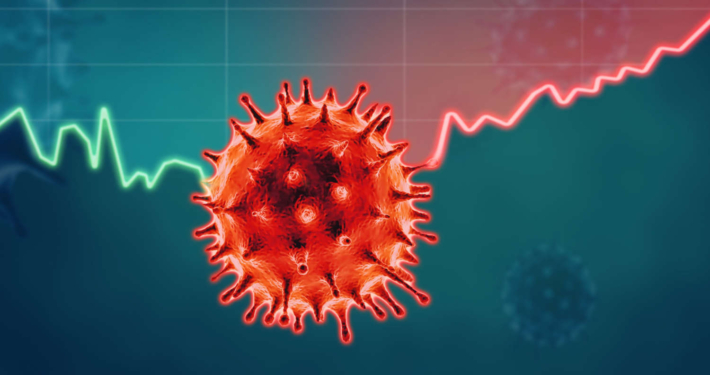Variants
As jabs go into arms and economies start reopening, this stage of the COVID-19 pandemic has been described as a race between vaccinations and new, potentially vaccine-resistant variants of the virus. This Research Monitor explores what we know about the key variants discovered so far, and what risks they pose.
How concerned should we be?
Viruses naturally mutate all the time, due to copying errors when they replicate inside host cells. Normally mutations rarely result in new, advantageous traits that allow them to outcompete other strains to become dominant within a community. However, since SARS-CoV-2 has spread so widely, several concerning COVID-19 variants have been able to emerge globally.
When judging the risk posed by a particular variant, there are three main things to consider: how well it spreads (transmissibility); how well it evades the immune response, whether naturally acquired or induced by vaccines or other treatment (immune neutralisation / escape); and whether it kills or hospitalises higher numbers of infected people (disease severity).
How dangerous these traits are depends on the context. Take the “Delta” variant B.1.617 (previously known as the “Indian variant” prior to the WHO’s new variant-naming conventions), a highly transmissible variant that has shown limited capacity to evade vaccines. In an unvaccinated population this virus would spread and kill many, but in a vaccinated population it will still spread but with fewer fatal results. This appears to reflect the difference between what is currently happening in India and in the UK with that same variant.
However, experts have warned of a different risk in populations such as the UK’s where many people may only have had one jab of a two-dose regimen. Exposure to a partial vaccine response provides an opportunity for the virus to mutate again and evolve better vaccine resistance.
There are, however, reasons why the variants seen so far should not be considered overly worrying. For starters, many of the vaccines being rolled out have very high efficacy rates, and even when new variants evade them, studies show, the vaccines remain very effective. We are also seeing that far fewer vaccinated people who do get infected are ending up in hospital or dead, with few variants thus far causing a dramatic increase in disease severity.
Even more promisingly, the exact same mutations keep cropping up in different variants across the globe, a phenomenon called “convergent evolution”. This helps scientists apply the same techniques for combatting different variants that arise. Vaccine developers are already working hard to tackle the variants we think might escape vaccine response; Moderna for example has begun trials on a jab against the South African variant.
That said, the best way to stymie the evolution of scarier variants is to roll out vaccines rapidly across the globe, limiting opportunities for the virus to spread and mutate.
Variants of concern
When a variant is first detected it is monitored and may be officially upgraded to a “variant of interest” or, for the most threatening variants, a “variant of concern”. This classification is done by individual health authorities, which is why, for example, the “variant of concern” list for the US and EU are slightly different. Below we look at some key variants of concern.
B.1.1.7 (Alpha)
Likely origin: Kent, southeast England, September 2020. Now dominant in many countries worldwide.
Impact: Responsible for pandemic peaks which swept the UK then Europe in winter/spring 2021.
Mutations: N501Y and P681H make this variant highly transmissible.
Related variants: Variant “B.1.1.7 + E484K”, also originating in the UK, carries an additional mutation E484K linked to vaccine escape.
B.1.617 (Kappa / Delta)
Likely origin: India, October 2020.
Impact: Driving the crisis in India, now spreading elsewhere - especially the UK.
Related variants: Three subtypes detected, each with slightly different mutations: B.1.617.1 (Kappa, the “original”), B.1.617.2 (Delta, the subtype spreading in the UK), and B.1.617.3.
Mutations: T478K (only in Delta) and L452R make the variant highly transmissible and are linked to vaccine escape. E484Q is even more strongly linked to vaccine escape but is only found in the original Kappa subtype.
B.1.351 (Beta)
Likely origin: South Africa, December 2020.
Impact: Caused concern when trials showed a strong ability to escape the immune response.
Mutations: E484K means antibodies cannot bind as strongly to the virus. K417N has a similar effect but also sacrifices the virus’ ability to bind to host cell receptors, with suggestions this might be making it uncompetitive.
P.1 (Gamma)
Likely origin: First detected in passengers arriving in Japan from Manaus, traced back to Brazilian samples from December 2020.
Impact: Drove the health crisis which struck Brazil in winter/spring 2021, now hitting other Latin American countries.
Mutations: Similar to the South African variant, N501Y makes it more transmissible and E484K provides a degree of vaccine escape.
Related variants: P.2 (Zeta) is also widespread in Brazil but has fewer mutations of concern.
Variants of interest
Many other variants have emerged independently across the globe, with several sharing the same mutations as those variants described above. Two variants that emerged in California in February 2021 (B.1.427 and B.1.429, jointly labelled “Epsilon”) are rated as “variants of concern” by the US after showing higher transmissibility, but react well to current vaccines. Variants detected in Nigeria (B.1.525, Eta), New York (B.1.526, Iota) and the Philippines (P.3, Theta) all share the E484K mutation that allows the Beta and Gamma variants to evade antibodies. The EU is also currently monitoring other variants originating in France, Colombia, Peru, Egypt, Russia and Mexico.
Tracking variants
Tracking variants relies on two fields of science working together. Standard epidemiology helps scientists understand where, how fast and among which parts of the population a virus is spreading. Any changes in expected patterns is a good sign of a new variant emerging. Genomic sequencing then allows us to understand why this is happening, for example whether a mutation has occurred locally or been brought into the community from elsewhere. This relies on samples collected by testing the population, but also novel approaches such as sampling sewage to trace variants within a community.
The UK has an impressive genomic sequencing operation, processing hundreds of thousands of samples every week and providing data to health authorities in around 24 hours. As of April, the COVID-19 Genomics UK Consortium (COG-UK) had generated almost half of all the genomic data on COVID-19 worldwide. That is a great figure for the UK, but raises serious concerns about other parts of the world where the virus is spreading and mutating without being studied in such depth. The most pertinent example currently is in the Indian countryside, where even the number of cases is hard to ascertain, let alone the emergence of any new variants.
Variants here to stay
Most scientists now believe SARS-CoV-2 will never be fully eradicated, with one survey for the journal Nature finding early this year that almost 90% of experts thought it was destined to become endemic. A historical parallel might be the so-called “Spanish flu”, which devastated the world in 1918 but later faded into the background, becoming the evolutionary ancestor of other flus, occasionally flaring up in more lethal outbreaks during the century. We should expect COVID to continue throwing up new variants as well. That means the efforts to monitor and control those variants — through tracking cases, sequencing genes and developing better vaccines — will remain essential for the foreseeable future.
Photo by Fusion Medical Animation on Unsplash
GCPPP Newsletter
We now publish a weekly newsletter to inform friends and supporters of the Global Commission's progress and to provide updates when new content is published. Please sign up here:








